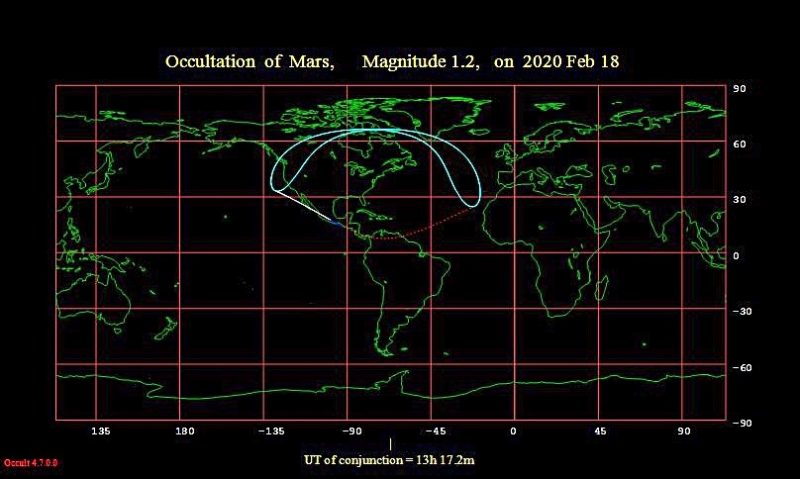
On the above sky chart above, we don’t show the moon for February 18, 2020, because – from a good swath of North America – it’ll actually be in front of Mars, and covering over the red planet. The moon, forever in motion in front of the constellations of the zodiac, swings in the vicinity of Jupiter on February 19 and to the south of Saturn on February 20.
If you’re on the right place on Earth’s surface, you can watch the moon occult (cover over) Mars on February 18, and then Jupiter on February 19. We elaborate on these lunar occultations later on in our post.
Although the above chart is especially designed for mid-northern latitudes in North America, it should work for your part of the world, too. From around the world, these three planets line up across the early morning sky, with Mars at top, and Saturn at bottom. The brightest of the threesome – the king planet Jupiter – resides in between Mars and Saturn.
Click on Heavens-Above to find out which constellation of the zodiac presently backdrops the moon
From the Southern Hemisphere and northern tropics, however, this planetary line-up appears more straight up and down relative to the horizon. At far northern latitudes, this line-up pf planets even makes a shallower angle with the horizon than at mid-northern latitudes. In short, all these planets come up sooner before the sun at more southerly latitudes.
60 degrees north latitude
Saturn rises 2/3 hour before sunrise40 degrees north latitude
Saturn rises 1 1/2 hours before sunriseEquator (0 degrees latitude)
Saturn rises 2 hours before sunrise35 degrees south latitude
Saturn rises 2 2/5 hours before sunrise
Want more specific information? Find out when the planets rise in your sky at TimeandDate
The moon is harder to pin down because it moves more quickly than the much slower-moving planets do in front of the “fixed” stars of the zodiac. Look first for the moon, and then seek out the string of planets crossing your sky. From the western half of the United States, you can watch the moon occult Mars during the predawn hours on February 18.
Read more: Lunar occultation of Mars February 18

Image via IOTA. See the loop at the upper right above North America? As the moon rises in the predawn hours on February 18, 2020, in this part of the world, Mars will covered over by the moon. But, later on before dawn, you can watch Mars reappear from behind the moon’s dark side. Read more.
Few, if any, people will see the lunar occultation of Jupiter on February 19, because it happens in Antarctica and the southern tip of South America.
But no matter where you live worldwide, watch for the waning crescent moon to sweep by the three morning planets: Mars, Jupiter and Saturn.
from EarthSky https://ift.tt/2Smbws1

On the above sky chart above, we don’t show the moon for February 18, 2020, because – from a good swath of North America – it’ll actually be in front of Mars, and covering over the red planet. The moon, forever in motion in front of the constellations of the zodiac, swings in the vicinity of Jupiter on February 19 and to the south of Saturn on February 20.
If you’re on the right place on Earth’s surface, you can watch the moon occult (cover over) Mars on February 18, and then Jupiter on February 19. We elaborate on these lunar occultations later on in our post.
Although the above chart is especially designed for mid-northern latitudes in North America, it should work for your part of the world, too. From around the world, these three planets line up across the early morning sky, with Mars at top, and Saturn at bottom. The brightest of the threesome – the king planet Jupiter – resides in between Mars and Saturn.
Click on Heavens-Above to find out which constellation of the zodiac presently backdrops the moon
From the Southern Hemisphere and northern tropics, however, this planetary line-up appears more straight up and down relative to the horizon. At far northern latitudes, this line-up pf planets even makes a shallower angle with the horizon than at mid-northern latitudes. In short, all these planets come up sooner before the sun at more southerly latitudes.
60 degrees north latitude
Saturn rises 2/3 hour before sunrise40 degrees north latitude
Saturn rises 1 1/2 hours before sunriseEquator (0 degrees latitude)
Saturn rises 2 hours before sunrise35 degrees south latitude
Saturn rises 2 2/5 hours before sunrise
Want more specific information? Find out when the planets rise in your sky at TimeandDate
The moon is harder to pin down because it moves more quickly than the much slower-moving planets do in front of the “fixed” stars of the zodiac. Look first for the moon, and then seek out the string of planets crossing your sky. From the western half of the United States, you can watch the moon occult Mars during the predawn hours on February 18.
Read more: Lunar occultation of Mars February 18

Image via IOTA. See the loop at the upper right above North America? As the moon rises in the predawn hours on February 18, 2020, in this part of the world, Mars will covered over by the moon. But, later on before dawn, you can watch Mars reappear from behind the moon’s dark side. Read more.
Few, if any, people will see the lunar occultation of Jupiter on February 19, because it happens in Antarctica and the southern tip of South America.
But no matter where you live worldwide, watch for the waning crescent moon to sweep by the three morning planets: Mars, Jupiter and Saturn.
from EarthSky https://ift.tt/2Smbws1

Aucun commentaire:
Enregistrer un commentaire